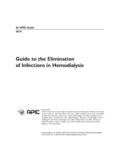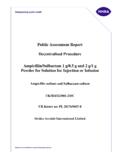Transcription of DRUG NAME: Carboplatin - BC Cancer
1 Carboplatin drug name : Carboplatin SYNONYM(S): CBDCA, JM8, NSC 241240 COMMON TRADE name (S): PARAPLATIN , PARAPLATIN-AQ CLASSIFICATION: Alkylating agent Special pediatric considerations are noted when applicable, otherwise adult provisions apply. MECHANISM OF ACTION: Carboplatin is an analog of cisplatin. Like cisplatin, it contains a platinum atom surrounded in a plane by two ammonia groups and two other ligands in the cis position. The other two ligands in Carboplatin are present in a ring structure rather than as two chloride atoms in cisplatin. This difference makes Carboplatin more stable and has less nephrotoxicity, neurotoxicity, ototoxicity and ,2 The exact mechanism of action of Carboplatin is not known. Carboplatin undergoes intracellular activation to form reactive platinum complexes which are believed to inhibit DNA synthesis by forming interstrand and intrastrand cross-linking of DNA molecules. Carboplatin is a radiation-sensitizing ,4 It is cell cycle-phase PHARMACOKINETICS: Interpatient variability 2- to 3-fold variability in AUC with BSA-based ,6 Variability can be reduced with Calvert AUC-based dosing ,7 Oral Absorption poorly absorbed; oral route not used clinically8 Intraperitoneal Absorption peak plasma level within 2-4 h after intraperitoneal instillation with 65% of dose absorbed over 4 h of dwelling2,9 widely distributed, mostly in kidney, liver, skin, tumour tissue; also in erythrocytes cross blood brain barrier?
2 Yes volume of distribution10 ultrafilterable platinum : 17 2 m2 Distribution plasma protein binding Carboplatin : minimal2,11 platinum: 87%,2,12 undergoes intracellular hydrolysis to form reactive platinum complexes active metabolite(s) platinum complexes Metabolism inactive metabolite(s) no information found renal excretion via glomerular filtration; extensively removed by hemodialysis. urine 71% within 24 h terminal half life days (total platinum*)1,10 platinum elimination from erythrocytes: 12 days Excretion clearance L/ m2 (total platinum*)10 Gender no information found Elderly clearance may be reduced due to age-related renal function impairment2,11 Children similar to adults6,13 Ethnicity no information found Adapted from reference2 unless specified otherwise.
3 Ultrafilterable platinum consists of Carboplatin and free Carboplatin metabolites; total platinum consists of protein bound and free platinum. Pharmacokinetics of ultrafilterable platinum is clinically more useful as only free platinum species are BC Cancer Agency Cancer drug Manual Page 1 of 9 Carboplatin Developed: September 1994 Revised: March 2006 Limited revision: May 2007, 1 June 2011, 1 January 2014 Carboplatin USES: Primary uses: Other uses: Brain tumours11 Bladder cancer11 Endometrial cancer11 Breast cancer2 Germ cell tumours11 Cervical cancer2 Head and neck cancer2,11 Ewing s sarcoma5 Ovarian cancer1,11 Leukemia, acute lymphocytic5 Lung Cancer , non-small cell2,11 Lung Cancer , small cell2,11 Lymphoma.
4 Non-Hodgkin s14 Melanoma11 Neuroblastoma2,5 Osteosarcoma5,15 Rhabdomyosarcoma5 Retinoblastoma2,5 Testicular cancer2,11 Wilms tumour2 *Health Canada Therapeutic Products Programme approved indication SPECIAL PRECAUTIONS: Contraindication: Manufacturer states that Carboplatin is contraindicated in patients with known hypersensitivity to Carboplatin , other platinum agents (eg, cisplatin) or However, with appropriate precautions, rechallenging with Carboplatin or switching to cisplatin has been tolerated by some patients with hypersensitivity reactions to ,16,17 Geriatrics: Incidence of peripheral neuropathy is increased and myelosuppression may be more severe in patients older than 65 years of age.
5 In addition, elderly patients are more likely to have age-related renal function impairment, which may require dosage reduction and careful monitoring of blood ,11 Prior exposure to cisplatin: increases the risk and severity of toxicities (eg, myelosuppression, nausea, vomiting, peripheral neuropathy, ototoxicity).12 Carcinogenicity: has not been fully studied, but drugs with similar mechanisms of action and mutagenicity have been reported to be Mutagenicity: mutagenic in both in vitro and in vivo Fertility: may cause gonadal suppression (amenorrhea, azoospermia) which is generally related to dose and length of therapy and may be Pregnancy: FDA Pregnancy Category There is positive evidence of human fetal risk, but the benefits from use in pregnant women may be acceptable despite the risk (eg, if the drug is needed in a life-threatening situation or for a serious disease for which safer drugs cannot be used or are ineffective). Breastfeeding is not recommended due to the potential secretion into breast BC Cancer Agency Cancer drug Manual Page 2 of 9 Carboplatin Developed: September 1994 Revised: March 2006 Limited revision: May 2007, 1 June 2011, 1 January 2014 Carboplatin SIDE EFFECTS: The table includes adverse events that presented during drug treatment but may not necessarily have a causal relationship with the drug .
6 Because clinical trials are conducted under very specific conditions, the adverse event rates observed may not reflect the rates observed in clinical practice. Adverse events are generally included if they were reported in more than 1% of patients in the product monograph or pivotal trials, and/or determined to be clinically important. ORGAN SITE SIDE EFFECT Clinically important side effects are in bold, italics allergy/immunology hypersensitivity (2-30%)18-20 auditory/hearing ototoxicity (tinnitus, visual and taste disturbances) (1%) anemia (71%) leukopenia (severe 14%); nadir 21 days, recovery 30 days11 neutropenia (severe 18%); nadir 21-28 days, recovery 35 days11 blood/bone marrow febrile neutropenia thrombocytopenia (severe 25%); nadir 21 days, recovery 30 days11 constitutional symptoms asthenia (8%) extravasation hazard: nonvesicant dermatology/skin alopecia (3%) emetogenic potential.
7 High moderate constipation (6%) diarrhea (6%) nausea (15%) gastrointestinal vomiting (64%) elevated alkaline phosphatase (24%) elevated AST (15%) hepatic elevated bilirubin (5%) infection infections (4%) hypocalcemia (22%) hypomagnesemia (29%) hypokalemia (20%) hyponatremia (29%) increased BUN (14%) metabolic/laboratory increased uric acid (5%) CNS symptoms (5%)2 neurology peripheral neuropathy (4%) ocular/visual visual disturbances (rare)2 pain abdominal pain (17%) acute renal failure (rare)2 decreased creatinine clearance (27%) renal/genitourinary increased serum creatinine (6%) syndromes hemolytic-uremic syndrome (rare) Adapted from reference12 unless specified otherwise. BC Cancer Agency Cancer drug Manual Page 3 of 9 Carboplatin Developed: September 1994 Revised: March 2006 Limited revision: May 2007, 1 June 2011, 1 January 2014 Carboplatin Myelosuppression is the dose-limiting toxicity, usually manifested as thrombocytopenia and less commonly as leukopenia, neutropenia and anemia.
8 Risk factors include prior cytotoxic therapy (especially cisplatin), poor performance status, old age, impaired renal function and concurrent myelosuppressive ,12 Myelosuppression is dose dependent, closely related to the renal clearance of Carboplatin , and minimized by using the Calvert AUC-based dosing ,12 Anemia is more common with increased Carboplatin exposure and blood transfusions may be needed during prolonged Carboplatin therapy (eg, more than 6 cycles).2 Hypersensitivity has been reported in 2% of patients receiving Carboplatin alone and in 9-30% patients receiving Carboplatin with other cytotoxic Reactions are similar to those seen with other platinum agents (eg, cisplatin) and include anaphylaxis and anaphylactoid Symptoms may vary in severity and include pruritus, rash, palmar erythema, fever, chills, rigors, swelling (face, tongue, infusion arm), GI upset, dyspnea, wheezing, tachycardia, and hypertension or ,19 Reactions can develop during or several hours to days after Carboplatin administration.
9 The risk of reactions increases with repeated exposure to platinum agents,18,19 particularly after 7 courses of Carboplatin or receiving the second course of Carboplatin after prior platinum ,19 The hypersensitivity appears to be mainly an IgE-mediated type I immediate reaction but may also involve direct histamine release. Some reactions may also be due to the mannitol present in some Carboplatin Management includes prompt treatment of anaphylaxis (see BCCA Hypersensitivity Guidelines) and oral diphenhydramine 25-50 mg every 4-6 hours for minor delayed In some cases, Carboplatin therapy may be continued with prophylactic corticosteroid and antihistamine and/or ,19 Nausea and vomiting usually begin within 6-12 hours after administration and may persist up to 24 hours or longer. Acute vomiting appears to be mediated by local GI and central serotonin mechanisms and is most common in patients with prior emetogenic cytotoxic therapy or receiving concurrent emetogenic agents.
10 The incidence and severity of vomiting may be reduced by prophylactic antiemetics. There is some evidence that the incidence of nausea and vomiting is reduced when Carboplatin is given as a 24-hour continuous IV infusion or in divided doses over 5 consecutive Neurotoxicity such as peripheral sensory neuropathy (eg, paresthesia) is less frequent or severe than with cisplatin. Peripheral neuropathy is more common in patients over 65, receiving prolonged Carboplatin therapy or with prior cisplatin therapy. Patients with pre-existing cisplatin-induced peripheral neurotoxicity generally do not worsen during Carboplatin Neurologic evaluations should be performed Nephrotoxicity: is less common or severe than with cisplatin; concomitant IV hydration and diuresis generally are not needed with ,2 The risk and severity of nephrotoxicity are increased with high dose Carboplatin regimen, especially when given concurrently with other nephrotoxic ,23 INTERACTIONS: AGENT EFFECT MECHANISM MANAGEMENT aminoglycosides (eg, amikacin, gentamycin, tobramycin)2 increased risk of Carboplatin nephrotoxicity and ototoxicity additive use with caution during concurrent therapy phenytoin24,25 decreased serum phenytoin level possibly decreased absorption or increased metabolism of phenytoin monitor serum phenytoin level carefully during and after Carboplatin therapy.















